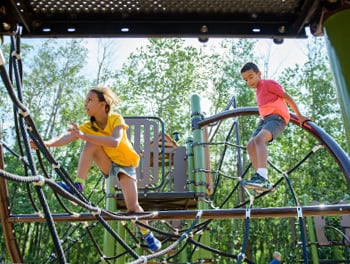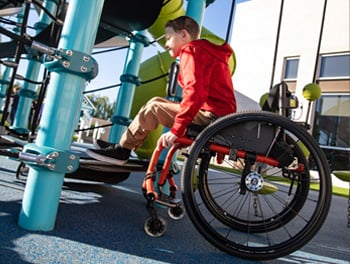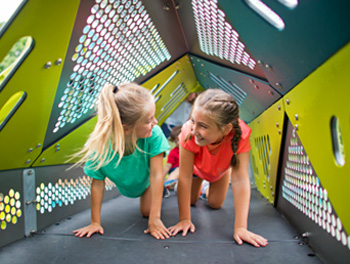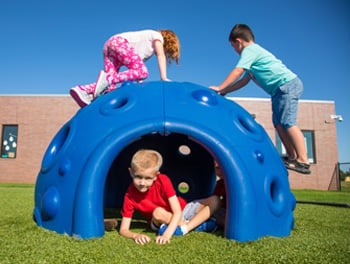History of Inclusive Play

History of Playgrounds
Play is incredibly natural to children and offers many benefits to a developing brain and body. While play can happen anywhere, studies have shown the valuable role playgrounds provide in facilitating and enhancing the physical, social and emotional benefits of play.

According to the National Trust for Historic Preservation, the first resemblance of a playground and the beginning of the playground movement is credited to a “Sand Garden” in Boston in 1887. As industrialization and urbanization grew, so did the concern for children growing up in cramped quarters with poor air quality and low social interaction. A new playground concept was introduced in the early 20th Century as a way to keep children off the streets and help them improve their physical health, develop social skills and have fun.
In 1906, the Playground Association of America formed to promote ideas of playgrounds to communities, including their benefits, construction information, layout and design ideas, and suggestions for the behavior and activities that should occur on playgrounds.
History of Inclusive Play
Playground aesthetics continued to evolve for nearly a century before formal guidelines were put in place that acknowledged people with disabilities. In 1990, the Americans with Disabilities Act (ADA) became law. The ADA is a civil rights law that prohibits discrimination against individuals with disabilities in all areas of public life including jobs, schools, transportation, and all public and private places that are open to the general public, which includes playgrounds.
An ADA-compliant playground must be accessible via wheelchair ramps and/or barrier-free travel routes, include a variety of accessible play options and provide an appropriate surface beneath all accessible equipment.
In 1993, Landscape Structures founder Steve King began serving on the Federal Access Board’s Recreation Access Advisory Committee as the groups only representative from a playground equipment manufacturer. At that time, nobody understood how to make playground accessible. Steve began by bringing the user voice into development. At a hearing, Steve asked a man in a wheelchair how he gets in and out of bed and how he uses a bathroom and shower. The man laughed and said, “Nobody ever asks us questions like that,” and then he proceeded to explain.
 That day Steve learned that many people with disabilities can scoot upstairs and learned the different ways they transfer themselves from wheelchairs to other kinds of furnishings. These direct observations were immediately implemented into Landscape Structures’ product research and development. As a result, Landscape Structures was the first playground manufacturer to design a transfer module into playstructures. We were also the first to introduce a multi-user glider, the Sway Fun® Glider, that was the first of its kind to be accessible to children and adults in wheelchairs.
That day Steve learned that many people with disabilities can scoot upstairs and learned the different ways they transfer themselves from wheelchairs to other kinds of furnishings. These direct observations were immediately implemented into Landscape Structures’ product research and development. As a result, Landscape Structures was the first playground manufacturer to design a transfer module into playstructures. We were also the first to introduce a multi-user glider, the Sway Fun® Glider, that was the first of its kind to be accessible to children and adults in wheelchairs.
Landscape Structures continues to innovate today using the user voice in development. Our Inclusive Play philosophy has led to the introduction of playground equipment that pushes past mere accessibility to create environments for play that serve sensory, physical, cognitive, social and emotional needs of all children in a community, regardless of ability. In 2021, the introduction of the We-Go-Swing® was the first no-transfer inclusive swing that can be integrated into the playground setting. This innovation finally created opportunities to enjoy one of the best parts of playgrounds – swings!
Landscape Structures and Inclusive Play
Steve was not only the creator of revolutionary concept of continuous play, but he’s also played a critical role in shaping the inclusive play movement. As a champion for inclusive play, Steve has volunteered countless hours on Federal Committees and Advisory Boards to provide a voice for those with disabilities and design equipment that welcomes, includes and challenges everyone.

For 20 years, Steve was chairman of a task group of the American Society for Testing and Materials (ASTM) that worked with the U.S. Consumer Products Safety Commission (CPSC) to update the ASTM F1487 Specification: a voluntary safety and accessibility standard for public playground equipment designed for children ages 2 to 12.
Additionally, his task group was responsible of developing playground accessibility standards to comply with the Americans with Disabilities Act (ADA). Accessibility was the first step towards inclusion, and he helped Landscape Structures become the first company to develop new playground components specifically meeting ADA requirements.
Future of Inclusive Play
While the ADA provides important standards ensuring accessible play areas for children with physical disabilities, the ADA requirements only address accessibility. At Landscape Structures, we believe in the need to go beyond accessibility and design playgrounds that are inclusive to everyone. A truly inclusive playground will not only meet the needs of children using a mobility device but will also provide a welcoming environment for children with sensory processing disorders, autism, down syndrome, and children with sight or hearing impairments.
 Inclusive playgrounds feature sensory-rich options such as activity panels that provide children with the opportunity to express themselves and learn in a variety of ways including music, touch and cognitive exploration. They also include areas where children who are prone to sensory overload can rest and reregulate before entering back into play, such as Cozy Domes.
Inclusive playgrounds feature sensory-rich options such as activity panels that provide children with the opportunity to express themselves and learn in a variety of ways including music, touch and cognitive exploration. They also include areas where children who are prone to sensory overload can rest and reregulate before entering back into play, such as Cozy Domes.
Landscape structures partners with like-minded organizations, such as Miracle League and Inclusion Matters by Shane’s Inspiration to advance inclusive play throughout the world. With the help of our Inclusive Play team, we work closely with Kanics Inclusive Design Services, LLC and our own Inclusive Play Specialist, Jill Moore. Jill also aids in adding user voice within product development and delivers accredited educational courses across the country. She is available to assist with any inclusive playground design questions, concerns or discuss further considerations.
Inclusive Playground History and Timeline:
- 1880s-1890s: Sand Gardens. These looked more like sandboxes in lots beside buildings.
- 1900s-1920s: Model Playgrounds. These were mostly tall apparatuses built with steel tubes, merry-go-rounds, and other spinning and twirling contraptions.
- 1930s-1940s: Development slowed due to the Great Depression and war efforts.
- 1940s-1950s: Adventures or Junk Playgrounds focused on going on an adventure and exploring through caves, over landscapes, building elements using found objects, without much supervision. Some of these playgrounds were accessible.
- 1950s-1970s: Novelty Playgrounds became popular with elements like rocket ships, slides, animal shapes, imaginative tunnels and shapes. Everything was still made of metal.
- 1970s-1980s: Standardized Playgrounds with rounded edges and hard plastic equipment were implemented in response to rising concerns about playground safety.
- 1980s-present: Modern Playgrounds began with a surge in imaginative playgrounds with safe surfaces, varying themes and materials.
- 1990 - the Americans with Disabilities Act (ADA) became law taking the first steps towards building a more inclusive playground experience for all
- 2000: Guidelines were created for the children's play space
- 2010: Guidelines became law
- Current: Communities around the world are discussing, creating, and building playgrounds that exceed the standards set in 2000 and including a wider range of disabilities than ever.
.
We believe all kids are created equal.
That's why we create play environments using inclusive playground equipment that welcome kids and families of all abilities to learn, play and grow together.